1
AZUSA, CLAREMONT,
LA VERNE, AND POMONA
The Mexican American “foothill communities” of Azusa, Claremont, La Verne, and Pomona played a vital role in what was once considered one of the richest agricultural areas in the United States. Carey McWilliams, the noted journalist and historian, wrote that this region was neither rural nor urban. Mexican Americans were systematically excluded and segregated by the various mainstream social institutions up until the later part of the 20th century.
Baseball and softball leagues served a pivotal role as athletic, entertainment, and social outlets in the historical evolution of these colonias. Consequently, throughout the decades, Mexican American baseball leagues and organizations evoked the formation of an important arena where Mexican Americans helped influence the larger society and contributed as a political vehicle that sought to expand the space of their lives.
Mexican Americans in the Pomona Valley, especially the foothill communities, were not socially immune from the terrible experiences that impacted their compatriots in the larger urban centers of this country, including educational segregation, police brutality, lack of adequate housing, low-paying jobs, and social segregation in public places including theaters, restaurants, and public pools. The baseball diamond was where the community came to cheer its favorite team and boo the opposing players, but it was also an arena where politics were discussed, strategies formulated, petitions and flyers circulated, money raised for campaigns and lawsuits, voters registered, citizenship information distributed, union dues collected, war bonds sold, and economic boycotts of specific downtown businesses that refused to serve Mexican Americans announced.
Thus, baseball and softball were intertwined within the larger agenda for political, educational, and civil rights. At all levels of ball, including youth, collegiate, adult, women, professional, and military, baseball had a political side. The elders made sure of it. Baseball in this region dates back to the early 1900s, and many of these teams and their families would later become the champions not only of baseball but also within the bigger diamond of American society.

The original families who settled Claremont worked at the citrus packinghouses, the Claremont Colleges, and, if they had talent, at the historic Padua Hills Theatre. Every Mexican Independence Day from the 1920s through the late 1930s, the elders organized a youth march from the East Barrio to Renwick Gymnasium at Pomona College, where they taught young people their Mexican history. A picture of Guadalupe Hidalgo, the priest who led the independence movement, hangs on the wall. (Courtesy of Alfonso Villanueva Jr.)
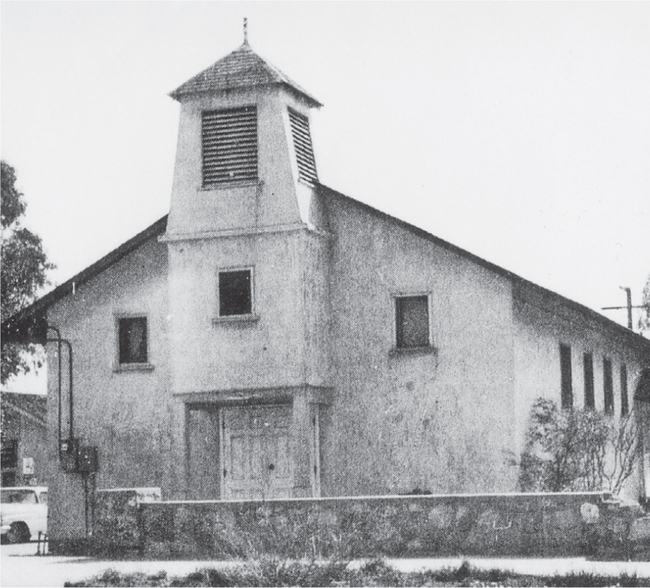
Mexican Americans were not welcomed to many Catholic churches throughout the country. This was their sad experience at St. Joseph’s in Pomona and St. George in Ontario. Sacred Heart of Jesus Chapel was built by the residents of both the East Barrio and Árbol Verde. It was built in 1938 after years of fundraising jamaicas. The first mass was held at the Enriguez home on Blanchard Place in Árbol Verde in 1912. Sacred Heart was razed in 1968 to widen Claremont Boulevard. (Courtesy of Alfonso Villanueva Jr.)
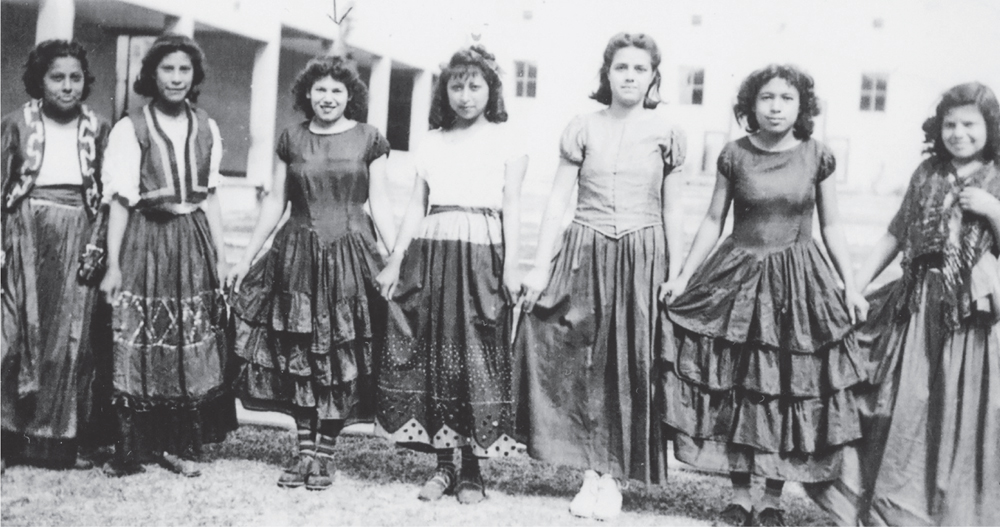
Dancing was an important form of cultural reaffirmation. Nearly every Mexican American community had a folklórico group of young women. Their teachers were often elderly women who had learned the regional dances from their elders in Mexico. It was not unusual to see these dance groups perform at local theaters, church functions, and during and after baseball games. From left to right are Angelina Elías, unidentified, Sarah Gallegos, Jennie Alanis, Carmen López, ? Terrones, and Virginia Miranda. (Courtesy of Lalo Olugués.)

This 1951 photograph depicts the star players of the Claremont Athletic Club that won the coveted Bradley Trophy as the best fast-pitch team in the Pomona Valley. From left to right are (first row) David Arnulfo Villanueva, and Tony Gómez; (second row) Ray “Poke” Guerrero, George Encinas, and Paul Gómez. “Poke” earned his nickname because he poked the ball hard and far. Paul Gómez was a successful police officer for the La Verne and Claremont departments. He passed away in 2013. (Courtesy of Rudy Gómez.)

This photograph shows another Claremont Athletic Club team. From left to right are (first row) batboys Rubén Gómez and Frank Molina Jr.; (second row) Freddie Gómez, Ray “Poke” Guerrero, Paul Gómez, Rigo Gómez, and manager Frank Molina; (third row) Joe Aguilera, Ramón Sevilla, Tony Gómez, Joe Félix, Román Salazar, and unidentified. Ramón and Mary Sevilla raised six children: Margaret, Ray, David, Danny, Richard, and Delia. Ramón was also a former professional wrestler. (Courtesy of Claremont Heritage.)
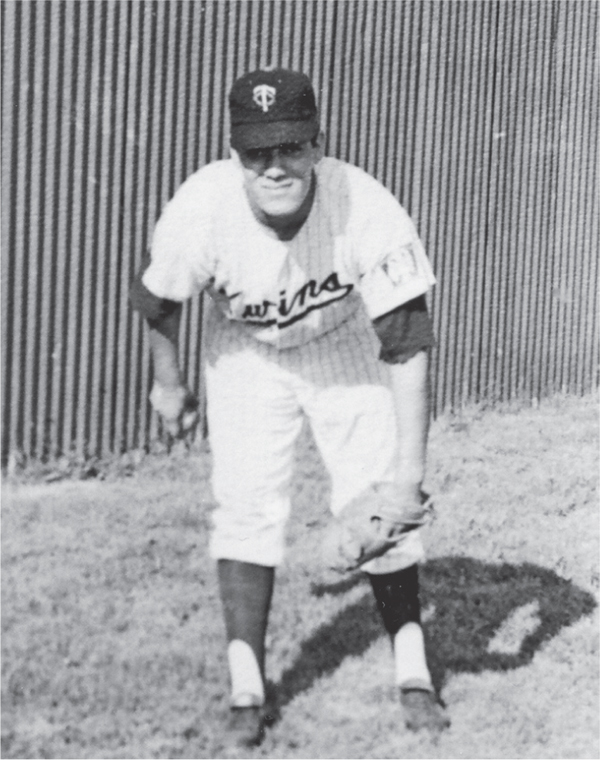
Ray Sevilla was born in 1941 in Pomona and raised in Claremont. He played softball since there was no Little League. He played hardball in the seventh grade and lettered three years at Claremont High School, where he was named All-League his last two years. He also played football for four years, leading his team to two California Interscholastic Federation championships. He played two years at San Bernardino Valley College and was signed by the Minnesota Twins in 1962, playing in their minor-league system. (Courtesy of Ray Sevilla.)

Tony Gómez (right) was born in 1925 to Frank and Leah Gómez in Claremont. Tony dropped out of Chaffee High School in Ontario to pick oranges for several citrus companies to help his family. During World War II, he served with the 112th Cavalry regimental combat team as a machine gun squad leader. He and Dolores Cuevas raised six children. He worked for Kaiser Steel in Fontana, from which he retired after 29 years. He pitched for the Kaiser softball team. Standing next to him is Louie Guevara. (Courtesy of Rudy Gómez.)

Nellie Gutiérrez Villanueva was born in 1932 in the Árbol barrio of Claremont. She posed for this photograph in 1956 while she was performing with the famous group Mexican Players and Dancers at the historical Padua Hills Theatre in Claremont. She met her future husband, Alfonso Villanueva, at a baseball game in 1947 when he was playing for the Question Marks. Both Nellie and Alfonso attended segregated schools in Claremont and Ontario, respectively. (Courtesy of Alfonso Villanueva Jr.)

Alfonso Villanueva Sr. was born in 1929 in the Sunkist barrio of Ontario, California. His mother, Luz, was one of the founding members of the Guadalupanas and his father, Emilio, was involved with La Progresistas Sociedad. Alfonso is featured in his Ontario Question Marks uniform in 1947. He was an outstanding softball hurler who could throw fast. Besides playing, Alfonso managed several teams from the 1960s through the early 1980s, winning several league and tournament championships in the Pomona Valley and Southern California. (Courtesy of Alfonso Villanueva Jr.)

Alfonso and Nellie Villanueva had five children, Yolanda, Alfonso Jr., Emilia, Rolando, and Steven. Alfonso Sr. (not shown) played for the Question Marks. Alfonso Jr. played with Montclair Pop Warner and Upland High School teams. He also played Upland and Claremont Little League and Pony League. Steven excelled in football and basketball. He quarterbacked the Claremont barrio football team against an undefeated Pomona “12th Street” team at El Barrio Park before 1,500 people from Pomona, Claremont, and surrounding communities. Rolando excelled in basketball and softball. (Courtesy of Alfonso Villanueva Jr.)
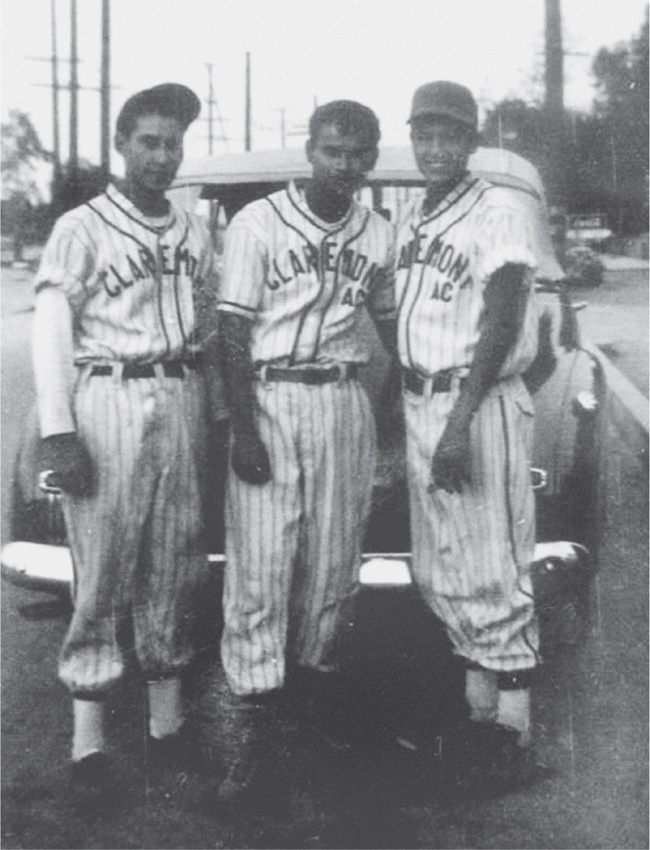
Seen here are three players for the Claremont Athletic Club. Ignacio Félix (center) was born in Claremont and still lives there today. He played baseball before going into the service during World War II, where he also played service ball. His brother, Joe Félix (left), was born in Pomona and grew up in Claremont. He served in the Air Force and later worked for Lockheed. Their teammate is Pat Martínez (right). Martínez worked for the highway patrol and is now a deacon. (Courtesy of Rudy Félix.)

Rudy Félix, the son of Ignacio Félix, played two years of Little League at shortstop and two years of Pony League in the outfield in Claremont during the 1960s. His Pony League team was the Yankees. Rudy also played 20 years on softball teams. He played many years for a team called the Sandbaggers. He has played on coed team including for the Costco store. Rudy has pitched, caught, and played outfield. He umpired three years for the Claremont Little League. He works with the US Postal Service. (Courtesy of Rudy Félix.)

Jerry Félix, brother of Rudy, played one year of Claremont Little League with the Red Sox in 1969. His position was outfielder. He went on to play with the Giants Colt League team in Claremont. Jerry also played 30 years of Unlimited Arc men’s softball as a pitcher. He managed the little-league team of Rudy’s son, Gabriel, in 1986. Jerry attended elementary, middle, and high school in Claremont. He currently works for the US Postal Service. (Courtesy of Jerry Félix.)

There were several packinghouses in the Pomona Valley, especially in Claremont. Most worksites had baseball and softball teams, often dominated by Mexican American players. This is the Sunkist Oranges team. From left to right are (kneeling) Pete Baltierra, Manuel Gonzáles, Vincent Álvarez, and three unidentified; (standing) Salvador Sevilla, Gilbert Guevara, Manuel Guevera, and Lupe Carmona; (sitting on the truck) Elías Guevara, unidentified, and Peter Belmúdez. (Courtesy of Gilbert Guevara.)

The employees of the Claremont Heights Orange and Lemon Association gather for a group photograph in 1951. The packinghouse was located on First Street just west of Indian Hill Boulevard in Claremont. Some of these men played for the Claremont Athletic Club baseball team. A few of the individuals in this picture are Katy Aguayo, Delia Martínez Félix, Ernie, Ignacio, and Joe Félix, Katie García, Freddie, Paul, and Tony Gomez, Trini Hernández, Alice Mendoza, and Helen Ruiz. Today, the packinghouse has been converted into shops and restaurants. (Courtesy of Rudy Félix.)

Joe Hermosillo was born and raised in Claremont and had an outstanding baseball and softball career. He and his brother Louie played on several youth teams, including Colt League and in high school. He later played in the semiprofessional Sunset League. This 1958 team, known as Nano’s, is, from left to right, (first row) Richard Sevilla, John Domínguez, and José Abundiz; (second row) David Sevilla, Nano Contreras, Danny Sevilla, Joe Hermosillo, Robert Sevilla, Raymond Cándelas, Tony Contreras, Steve ?, and Albert Gutiérrez. (Courtesy of Joe Hermosillo.)

Joe Romero was born in Las Cruces, New Mexico, and raised in Cucamonga. He played for the Nine Aces in 1952 with Richard Martínez, Al and Louis Vásquez, Tony Muñoz, and Richard Zacarro. Joe played for the Claremont Barons in 1963 and played and managed the Upland Angels. The Angels won the 1975 Sunset League championship, beating the Cucamonga Mets. Joe (third row, second from right) managed and played for Manny’s in San Bernardino. Other players included Joe Hermosillo, Rudy Mendoza, Manuel Martínez, and Pete Reyes. (Courtesy of Joe Romero.)
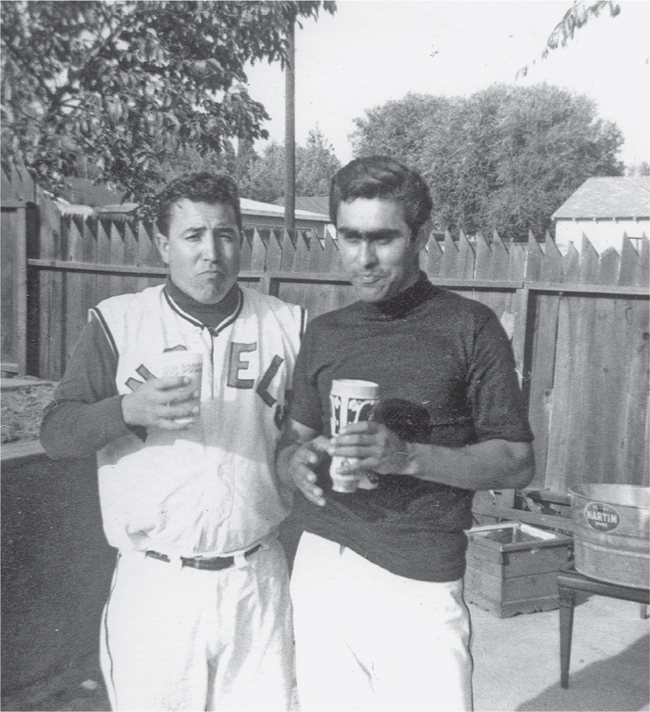
Joe Romero (left) and Joe Hermosillo (right) were very typical of players of their generation who played ball for several teams and communities. Although they mainly played ball in the Ontario and Upland areas, they played for and against teams in Claremont and San Bernardino. Moreover, it was not unusual to find crosstown marriages between Ontario and Upland with Claremont and Pomona. Many players in the Pomona Valley played in Mexico, having the advantage of speaking both Spanish and English. (Courtesy of Joe Romero.)

The 1936 Freemont Junior High School team included a handful of Mexican Americans, including Mike Miranda (second row, far left), George Encinas, and Eddie García. Mike Miranda would later become the mayor of Irwindale. George Encinas’s grandson, Chad Cordero, later played for the Los Angeles Angels of Anaheim baseball organization. (Courtesy of Eddie García Jr.)

The Pomona Merchants were a semipro team that played at Ralph Welsh Park in Pomona in the San Bernardino Valley League. From left to right are (kneeling) Gil Guevara, Landon Moore, Joey Fuentez, Dan Dioses, and Julio Rodríguez; (standing) Maury Encinas, George Estrella, Dick McAnulty (manager), Sisto Armenta, Vic López, Tommie Encinas, Bobby Duran, and Harry Estrella. (Courtesy of the Tommie Encinas family.)

Bobby Duran was born in 1927 to Melesio and Ramona Duran. There were six brothers, Alex, Luís, Mel Jr., Henry, Bobby, and Alfred. All of the Duran brothers were outstanding players in baseball, basketball, and football. Bobby’s five brothers served in World War II or Korea. Their father worked at the Kellogg Ranch, now Cal Poly Pomona, on the farm and with the Arabian horse show. Bobby would help his father at the ranch. Their father later worked for the City of Pomona. (Courtesy of Bobby Duran.)

This Fremont Junior High School team included several Mexican American players, including Vincent Álvarez, Soupy García, Tommie Encinas, Jess Trujillo, Robert Barela, Jimmy Turner Sr., Orlando Barela, Simón Baltierra, and Jess Ontiveros. (Courtesy of the Tommie Encinas family.)

Tommie Encinas was raised in Pomona, California, and is seen here in his Waco (Texas) Pirates uniform. Tommie was signed by the Boston Braves in 1946 and began his professional career in Leavenworth, Kansas, in the Class C Western Association. In 1947, Tommie was traded to the Pittsburgh Pirates organization, where he played for the Uniontown Coal Barons in Pennsylvania and the Selma Cloverleafs in Alabama. Tommie’s two brothers, George and Maury, were also star players in the Pomona Valley. (Courtesy of the Tommie Encinas family.)
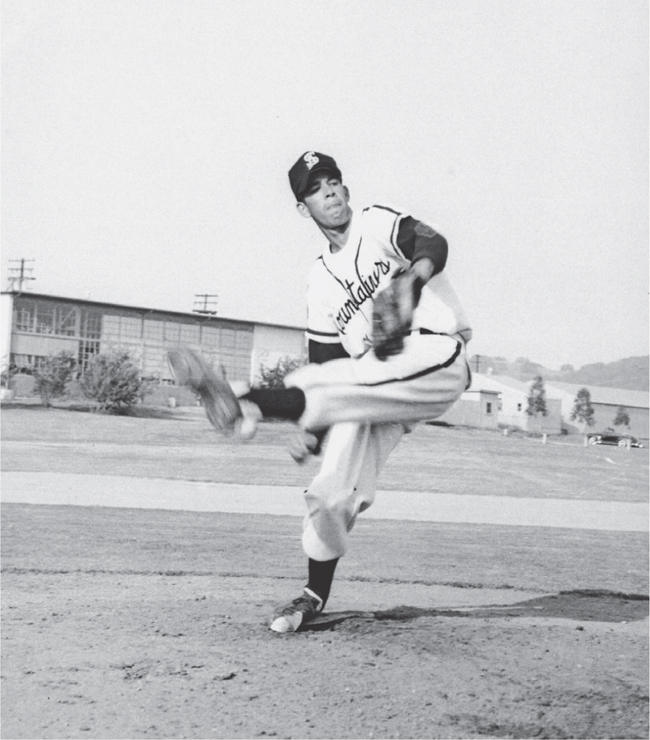
Buddy Muñoz was born in Miami, Arizona, and later moved to Pomona, California, where he was the MVP of his baseball team in both his junior and senior years at Pomona High School. He pitched for Mount San Antonio College in 1954 and 1955. He graduated from the University of Southern California with a master’s of business administration. He retired from the Los Angeles County Probation Department in 1992. His daughter, Kelli, played softball at Cal State San Bernardino in 1994–1995. She has been a winning softball coach for 20 years. (Courtesy of Buddy Muñoz.)

This 1963 Pomona American Little League team was coached by Bobby Duran (right). His three sons are on the team: Rod (first row, second from right), Bobby Jr. (third row, third from right), and Rudy (third row, fourth from right). Bobby’s three sons were outstanding athletes in football, basketball, and baseball. They played Little League, Pony League, and high school. Bobby Jr. played at Garey High School when they were the California Interscholastic Federations (CIF) champions. He also had a tryout with the Anaheim Angels. (Courtesy of Bobby Duran.)

Rudy Duran (second row, second from right) and his brother Bobby Jr. (second row, fourth from right) played for the Pomona Elks. During his illustrious career, Bobby Sr. played against the best teams and players. He played against the Encinas brothers from Pomona, the Uribe brothers from Corona, the Vásquez brothers from Cucamonga, and the Guevara brothers from Pomona. Their brother Rod (not pictured) was an outstanding hitter and fielder and had a great future but was seriously hurt when a coach pushed him too hard. (Courtesy of Bobby Duran.)

Bobby Duran started a youth league in Pomona and coached a team called the Jets until the age of 55. He later formed a senior team also called the Jets. He played with several senior teams including one in Chino until he retired from the game in his 80s. In his youth, Bobby was known as “the Jet” and “Relámpago”—Spanish for “lightning”—because he was so fast. He played ball in Mexicali with Maury Encinas for the Águilas, a Pittsburgh Pirates minor-league team. (Courtesy of Bobby Duran.)

Ralph Valadez played for the Ontario American Legion, was an All-League shortstop in his junior and senior years in high school during the early 1970s, and was selected to the California all-star team. He played at Chaffey Community College, helping the team win its league. He played at the University of La Verne as an outfielder and designated hitter. Ralph played two years of semipro ball in Halstead and Dodge City, Kansas, and was offered a contract by Minnesota Twins scout Jesse Flores. (Courtesy of Anita Valadez-García.)

The Mexican American community of La Verne has produced outstanding teams and extraordinary players since the 1930s. This is the Jones Texaco team from La Verne in the late 1940s. From left to right are (first row) Johnny Carmona, Steve Mora, Manuel García, Philip Banales, and David Rodríguez; (second row) Joe Ramírez, Buddy Soto, George Soto, and Pete Martínez; (third row) Jess Martínez, Benny Castellano, Pete Aguilera, Art Escoto, Nacho Martínez, Mr. Jones (team sponsor), and Fred Martínez (manager). (Courtesy of Vince Martínez.)
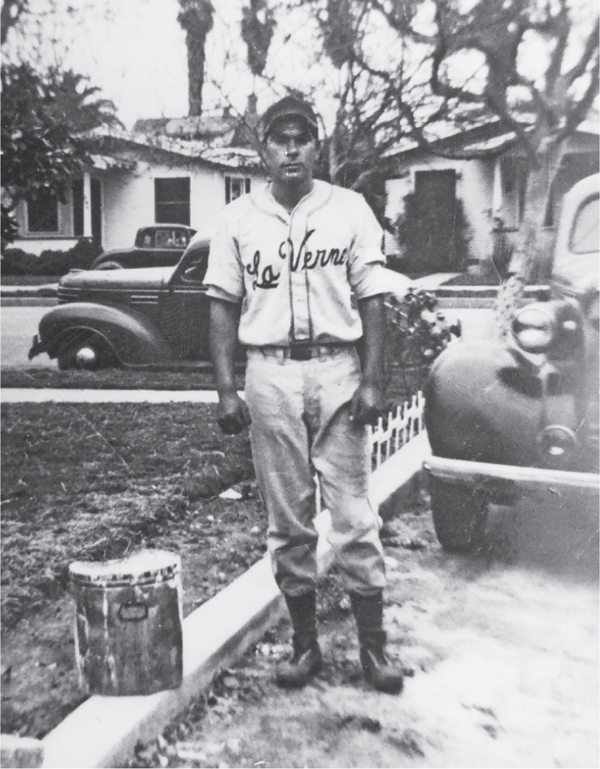
Although Bobby Duran was from Pomona, he was forced to play in La Verne in 1945 because the Pomona American Legion parents did not want Mexican kids playing with their kids. Bobby played for the La Verne Merchants. His manager was Charlie “La Tortuga” (the turtle) Rodríguez. Several teams scouted Bobby, including the Braves, Pirates, and Dodgers. Jackie Robinson spoke to Bobby about playing for the Dodgers’ minor-league system, but Bobby turned the offer down because the salary was too low to support a new family. (Courtesy of Bobby Duran.)

Manuel R. Romo purchased several lots of property behind Palomares School in La Verne where teams played baseball. Pictured on the left is Manuel’s second cousin Guadalupe Carmona, who worked hauling fruit but loved playing ball. The aunts who now own the lots would sell burritos during the games. Due to the widening of the road, many homes were torn down to build Arrow Highway. Today, a sign hangs above one of the uncles’ driveway gate that reads “Romo Land Est. 1900.” (Courtesy of Dennis Duke Romo.)
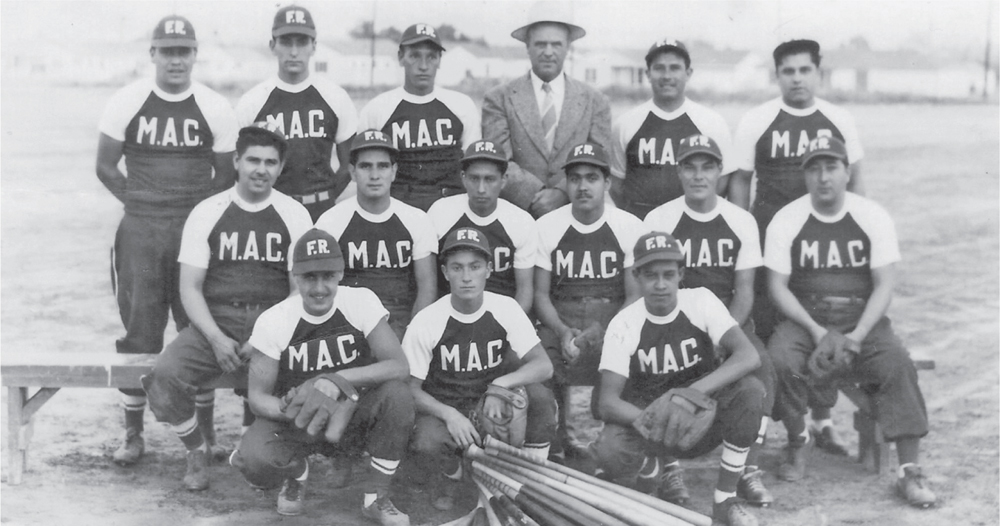
The 1947 Mexican American Athletic Club (MAC) from Azusa was comprised of players who had served in World War II. From left to right are (first row) Tony Arias, Oscar Aguirre, and Frank Irigoyen; (second row) Lino Arriaga, Bobby Álvarez, Henry Toledo, unidentified, Jesse Bracamontes, and Herman Domínguez; (third row) Salvador Luévanos, Tony Ortiz, Art ?, unidentified, Tony García, and Pete Gonzáles. Luévanos was scouted by the New York Giants. Toledo later served in the Korean War. The MAC team played against local teams including Ortuño’s Market. (Courtesy of Abe Contreras.)

Azusa has a rich history of Mexican Americans in sports. Mexican Americans were outstanding stars in youth leagues and in high school, lettering in baseball, basketball, football, tennis, and wrestling. Moreover, the young men of Azusa defended their country during World War II and Korea. This 1948 Azusa team was comprised of several extraordinary players, including Cruz Guerrero, Mike Miranda, Manuel Toledo, Hank Toledo, and Mickey Silva. Miranda and Silva were from nearby Irwindale. Manuel Toledo was the manager. (Courtesy of Henry Toledo.)

The 1968 Ontario Little League championship team was sponsored by Bumstead’s Sporting Goods store. There are several Mexican Americans on this team whose families have lived in Ontario for generations, including the four López cousins: Ron, Victor, Albert, and Enrique. Ontario American and Central Little Leagues played at Bud Eldrige Park, built in 1961 on what was formerly El Barrio del Chile, where chiles, sweet potatoes, and green beans were grown. Ontario teams played against Pomona, Claremont, Azusa, and La Verne. (Courtesy of Enrique López.)

































